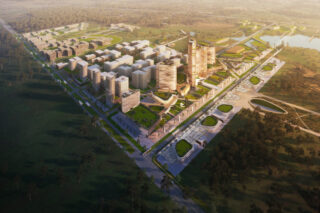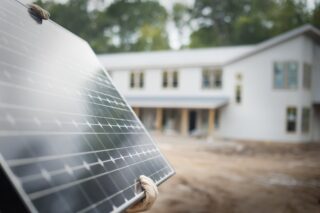Africa is leading the world in population growth, but its inferior infrastructure remains a major impediment to progress. In general, the continent’s roads, ports and airports lag far behind those in other parts of the globe.
The Proposal
Echoing Jeff Bezos’ plans to someday deliver Amazon products by drone, an exhibit at the 2016 Venice Architecture Biennale, which runs through November 27, proposes building drone ports to meet the African continent’s expanding needs. The exhibit consists of a prototype drone port situated at the edge of a canal adjacent to Venice’s Renaissance-era factory complex known as the Arsenale. A large vaulted brick structure with seemingly improbably thin walls, the Arsenale houses a small white drone with a black lens for a nose.
“The drone port is like a filling station for the future,” declared the renowned British architect, Sir Norman Foster, standing in front of the prototype at the Biennale’s opening in this past May. “The drones in an emerging economy like Africa,” he said, “would be able to leapfrog the lack of roads and deliver urgent medical supplies and cargo very, very cheaply and swiftly.”
A Tech Combo
Foster’s drone port prototype might look as though it was designed by a craftsperson, but it actually is a combination of high-tech and low-tech methods and materials. It was designed by a brain trust consisting of the Norman Foster Foundation, Future Africa EPFL the Philippe Block Research Group, ETH Zurich and ODB Engineering.
Built from a brick/tile hybrid product enhanced by an additive developed by Swiss-based LafargeHolcim Foundation for Sustainable Construction, the drone port is relatively lightweight and it packs a very small carbon footprint. It’s “transforming earth into a high-performance product and using an age-old form, the vault,” Foster said, “but in [such] a way [as] to reinvent it, and to create something that is also a presence in the landscape.”

Courtesy of Metalocus
Atypical Solution
Unlike typical modern buildings of today that defy gravity with metal rebar, bolts and other industrial materials, this vaulted structure relies on its walls alone to support its weight. Technically speaking, instead of depending on the force of tension for stability, the drone-port prototype is supported by the force of compression. Its secret is a new digital form, finding technology that allows architects to design structures with traditional materials that would otherwise be almost impossible to build.
“You cannot just create any geometry or it will fall down,” explains John Ochsendorf, an MIT professor who worked on the drone port prototype.
In Venice, he was at one of the Arsenale’s massive buildings, manning a separate exhibit of vaulted arch structures that he had worked on.
“Here, we are showing that there are many geometries waiting to be discovered.”
No Sacrifices
Another bonus is that unlike a lot of contemporary infrastructures, this relatively inexpensive environmentally sensitive structure is elegant and sleek.
“We are celebrating gravity by respecting the forces,” said Ochsendorf, “There is an honesty to the composition, and we don’t have to sacrifice beauty.”












